In this review we assessed the FBI's compliance with the Attorney General Guidelines and the methods by which the FBI enforced compliance with the Guidelines. We also evaluated how the FBI implemented the revised Investigative Guidelines. The importance of the implementation process was highlighted by Attorney General Ashcroft when he issued the new Guidelines. In a memorandum to the heads of all DOJ components dated May 30, 2002, the Attorney General stated:
I hereby direct all affected components to implement these revised guidelines and procedures, and to incorporate them as relevant into their training programs for new and current personnel. The new tools made available by the guidelines will only be effective if our agents and employees know how to use them.
We believe it is important to evaluate how the FBI implemented the revised Guidelines because lessons learned from this process can be useful when future changes to Guidelines are made. As explained below, we found several significant deficiencies in the FBI's process for implementing the revised Guidelines.
- The FBI's Implementation Process for the Revised Investigative Guidelines
- March 19, 2004, guidance emphasizing FBI policy regarding the protection of civil liberties in connection with use of authorities under both the Investigative Guidelines and the NSI Guidelines (OGC - "Protection of Civil Liberties");
- April 26, 2004, guidance clarifying the standards for collecting, retaining, and disseminating information in connection with the FBI's "Special Events" responsibilities (CTD - "Guidance to Atlanta, Boston and New York Divisions Concerning Information Collection, Maintenance, and Dissemination for G-8, DNC and RNC Special Events, 2004"); and
- September 1, 2004, guidance emphasizing the limitations on the Part VI authorities and specifying how to collect, maintain, and disseminate the information collected in connection with protest activity (CTD - "Law Enforcement Monitoring of Protest Groups for Indications of Criminal or Terrorist Activity").
- Administrative Support, Including Mechanisms to Promote Accountability
- Registration of Confidential Informants. The Confidential Informant Guidelines identify seven categories of information that must be documented in a CI's files upon registration. The MIOG omits one of these requirements - the requirement to document the promises or benefits that are given to a CI by any prosecuting office.
- Contingency Payments to Confidential Informants. The Confidential Informant Guidelines provide that payments to a confidential informant shall not be contingent upon the conviction or punishment of any individual. Neither the MIOG nor the FBI's Confidential Funding Guide contains a corresponding provision.
- Deactivation of Confidential Informants. The Confidential Informant Guidelines establish procedures when a CI is deactivated "for cause or for any other reason." For CIs who are not deactivated "for cause," the MIOG does not include the notification and documentation requirements contained in the Guidelines.
- Preparation of Undercover Employees, Informants, and Cooperating Witnesses. The Undercover Guidelines require the Special Agent in Charge (SAC) or Supervisory Special Agent (SSA) to review with an undercover employee the conduct that the undercover employee is expected to undertake, conduct that may be necessary during an operation, and any sensitive or fiscal circumstances that are reasonably likely to occur. The Field Guide omits the requirement to discuss sensitive or fiscal circumstances.
- Application/Notification to FBI Headquarters, Sensitive Circumstances. The MIOG omits the Undercover Guidelines' requirement that the letter from the "appropriate federal prosecutor" that is included in the FBI approval package for Group I UCOs provide a cost/benefit statement.393
- Authorizations for Openings and Renewals of Terrorism Enterprise Investigations. The General Crimes Guidelines provide that approval of initiations and renewals of terrorism enterprise investigations may be made by the SAC with notice to FBI Headquarters. The MIOG requires Headquarters approval for the initiation of TEIs by requiring concurrence of an appropriate Section Chief in the FBI's Counterterrorism Division.394
- Use of Mail Covers in Preliminary Inquiries. The revised Guidelines authorize the use of mail covers in preliminary inquiries in general crimes investigations. The MIOG prohibits mail covers in these investigations.
- Duration of Consensual Monitoring. We believe an ambiguity exists in the Consensual Monitoring Guidelines and MIOG regarding the authorization period for monitorings that do not involve the sensitive circumstances set forth in Section II.A of the Guidelines. For consensual monitorings that require DOJ approval, Section III.A.6 of the Consensual Monitoring Guidelines and the corresponding section of the MIOG (Part 2 § 10-10.3(9)(f)) impose a 90-day limit on authorizations. For non-sensitive matters, Section V of the Guidelines requires that the records for the monitoring include the information set forth in Section III.A, which provides that the request must "state the length of time needed for the monitoring" and establishes the 90-day authorization period described above (emphasis added). The MIOG provides, however, that in non-sensitive consensual monitorings, the SAC or ASAC may approve the monitoring "for the duration of the investigation," which, as explained in Chapter Six, the FBI has converted into a standard practice of authorizing non-sensitive monitorings for an extended period of time beyond 90 days.
- Emergency Procedures for Consensual Monitorings That Do Not Require DOJ Approval. The Consensual Monitoring Guidelines require the establishment of procedures for emergency authorizations in cases that do not require DOJ approval. The MIOG does not include such procedures.395
- OIG Analysis and Recommendations
To assess the procedures the FBI employed to implement the Investigative Guidelines, we interviewed FBI personnel, including representatives of the Office of the General Counsel (OGC), Inspection Division, and Training Division, and reviewed documents describing implementation activities. For example, we examined communications to FBI personnel relating to the May 2002 revisions and documents describing the FBI's plans for implementing the Guidelines. In addition, we reviewed reports, data, and other information provided to the Attorney General and DOJ components concerning the FBI's implementation activities.
Our review focused on four aspects of the FBI's implementation of the revised Guidelines: 1) initial planning; 2) communications and the provision of guidance to agents concerning the revisions; 3) training; and 4) administrative support. We summarize below our findings for each part of the implementation process.
Our review found that components within the FBI did not sufficiently coordinate planning to implement the revised Guidelines. Although Headquarters personnel told us that discussions occurred within various divisions and offices at FBI Headquarters regarding the need for new guidance and training, FBI officials told us that no office or entity provided coordinated oversight of the Guidelines implementation process.
Of all FBI components, OGC's role in the implementation process for the revised Guidelines was most prominent. It prepared guidance for the field and conducted some training sessions. See discussion in Sections II.B and C below. Without inter-division consultation and coordination, however, the implementation of the Guidelines proceeded in a patchwork fashion. For example, as we describe below, updating of the FBI's Manual of Investigative Operations and Guidelines (MIOG) was significantly delayed, and agent training needs were not timely identified and addressed.
OGC assumed responsibility for many of the communication-related tasks associated with notifying the field of the amendments to the Guidelines. On May 31, 2002, the day after the revised Guidelines were issued by the Attorney General and became effective, OGC e-mailed electronic copies of the four Investigative Guidelines to all Chief Division Counsel and announced plans to post the documents on the Investigative Law Unit's (ILU) Intranet website. The e-mail also explained that "ILU will be providing guidance regarding the implementation of the new guidelines in the near future." The FBI provided no other documentation to the OIG concerning its initial notification to its employees, such as a broadcast e-mail or posted Intranet announcement for all FBI agents.
From early June to October 2002, the FBI issued five sets of guidance documents concerning the revised Investigative Guidelines.387 On June 11, 2002, the Undercover and Sensitive Operations Unit (USOU) in the FBI's Criminal Investigative Division (CID) issued an electronic communication to all field offices and divisions announcing approval of the revised Field Guide for Undercover and Sensitive Operations (Field Guide) that incorporated changes required by modifications to the Undercover Guidelines. The electronic communication provided a 5-page summary outlining 12 important policy changes, including increased monetary limits for Group II UCOs and emergency approval procedures.
On July 5, 2002, OGC issued a 2-page electronic communication to all Divisions that described changes to the Consensual Monitoring Guidelines. On October 7, 2002, OGC sent a 15-page explanation to all divisions and Legats regarding the revisions to the General Crimes Guidelines. The electronic communication discussed changes to the major sections of the General Crimes Guidelines, including those addressing full investigations, racketeering enterprise investigations (REIs), terrorism enterprise investigations (TEIs), counterterrorism activities, and the dissemination of investigative information. With respect to counterterrorism activities involving visiting public places and events for the purpose of detecting or preventing terrorist activities, the guidance stated that, time permitting, agents should obtain their supervisor's approval for the visit and that no information collected should be retained unless it related to potential criminal or terrorist activity.
On August 6, 2002, the Criminal Intelligence Section issued to all field offices a 3-page explanation about the revisions to the Confidential Informant Guidelines. It described the changes to the Guidelines, including elimination of the requirements to read verbatim instructions to CIs and to obtain the CI's written acknowledgment that the CI had received the instructions.
The FBI's Counterterrorism Division issued an electronic communication to all field offices on August 8, 2002, concerning the initiation and renewal of TEIs. The guidance addressed issues such as predication standards and authorization levels and time periods. The Counterterrorism Division supplemented this guidance with an electronic communication to all field offices on January 2, 2003, describing the proper use of preliminary inquiries in TEIs.
Besides issuing explanatory electronic communications concerning changes to the Investigative Guidelines, the FBI took other steps to assist the field with interpreting the Guidelines and understanding related civil liberties issues. On March 27, 2003, OGC designated an attorney to coordinate guidance and assistance on investigative, operational, and policy matters concerning constitutional and privacy interests. The FBI also issued the following guidance documents (which are described more fully in Chapter Five):
Despite these and other guidance memoranda issued by FBI Headquarters, we found numerous instances where agents were not timely informed of Guidelines' requirements. Furthermore, we identified problems in communication between FBI Headquarters and the field concerning the requirements of the new Guidelines. For example, our survey of Division Counsel indicated that 55 percent said they believed that guidance is not clear with respect to Section VI.A.2 of the General Crimes Guidelines.388 Our survey of Confidential Informant Coordinators also revealed that 45 percent reported that communication breakdowns with FBI Headquarters regarding changed procedures resulting from the Guidelines revisions were a significant issue raised by agents in their respective field offices.
Our review of the FBI's training initiatives on the Investigative Guidelines revealed inadequate planning and poor coordination between Headquarters Divisions, with the consequence that nearly two years after the Guidelines were revised, key groups within the FBI reported significant deficiencies in both the sufficiency and effectiveness of the available Guidelines training. Our interviews revealed that no entity in the FBI made a determination regarding which agents or supervisory personnel should receive training, the form it should take (e.g., classroom, training by Division Counsel, or the use of computer-assisted tools such as CD-ROMs), and when it should be completed.
Training for FBI agents is provided by various sources, including OGC, the Training Division, and field and Headquarters operating divisions.389 The Training Division informed us that it does not maintain records on field or Headquarters training that does not involve Training Division resources. According to the Training Division, new agents receive copies of the Investigative Guidelines as well as instruction on Guidelines issues related to consensual monitoring, the operation of confidential informants, undercover operations, and investigative techniques. Guidelines instruction also is provided during in-service training at the FBI's training facility in Quantico, Virginia, in sessions for agents on domestic and international terrorism.
Chief Division Counsel in each field office also provide mandatory quarterly legal training for each field office. According to OGC, Guidelines issues are covered in this setting. However, OGC could not verify that the May 2002 revisions had been addressed by CDCs in all field offices. Moreover, CDCs did not themselves receive training on the revised Guidelines until a January 2003 CDC conference at FBI Headquarters.
Headquarters program units within the CID also provided training that addressed the Guidelines. For example, USOU provided Undercover Guidelines training on the Confidential Informant Guidelines in several courses that it sponsored as did the Asset/Informant Unit (A/IU).390 Finally, a limited number of courses that address Guidelines issues are available to FBI personnel through DOJ's Office of Legal Education (e.g., Online Undercover Investigations Seminar).
Yet, despite this training activity, our survey of FBI personnel revealed significant gaps and inconsistencies in the sufficiency and effectiveness of Guidelines training. For example, our survey of Division Counsel in early 2004 showed substantial variation in the percentage of agents in field offices who had received general training on each of the four Investigative Guidelines, apart from guidance provided by Division Counsel on particular cases. As shown below, only 19 percent of surveyed Division Counsel reported that all agents in their field office had received training on the General Crimes Guidelines (which includes the new anti-terrorism measures added with the May 2002 revisions), and 6 percent reported that no agents in their office had received such training. In addition, fewer than half of the respondents said that all agents in their respective field offices had received training on the revised Confidential Informant Guidelines.
DIAGRAM 8.1
Division Counsel Reporting of Special Agents who have Received
Training on the Investigative Guidelines in Their Field Offices
as of March 2004
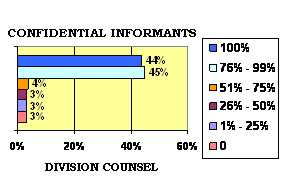
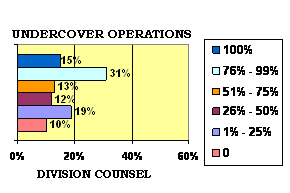

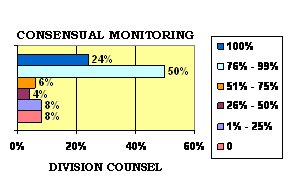
Our surveys further revealed that 65 percent of surveyed Division Counsel said they believed additional training or guidance on the revised Guidelines was necessary in their respective field offices. A high percentage of Division Counsel told us that agents and squad supervisors require additional training.
DIAGRAM 8.2
Division Counsel's Views on the Need
for Investigative Guidelines Training
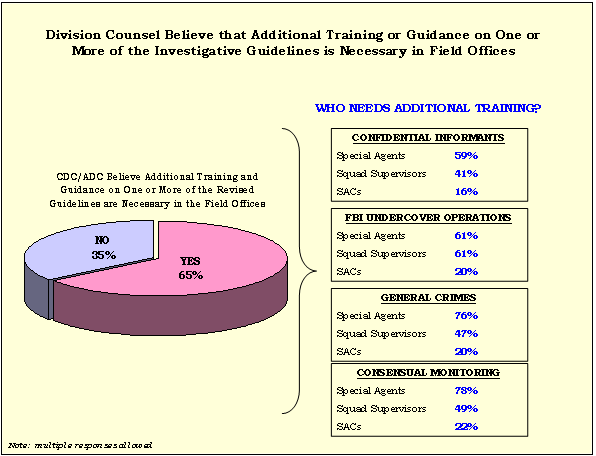
We also found that 63 percent of surveyed Division Counsel, 62 percent of Informant Coordinators, and 50 percent of surveyed Undercover Coordinators said they believed they needed additional training on the Investigative Guidelines. The diagram below summarizes the views of Informant Coordinators:
DIAGRAM 8.3
Confidential Informant Coordinators' Views on the Need
for Investigative Guidelines Training
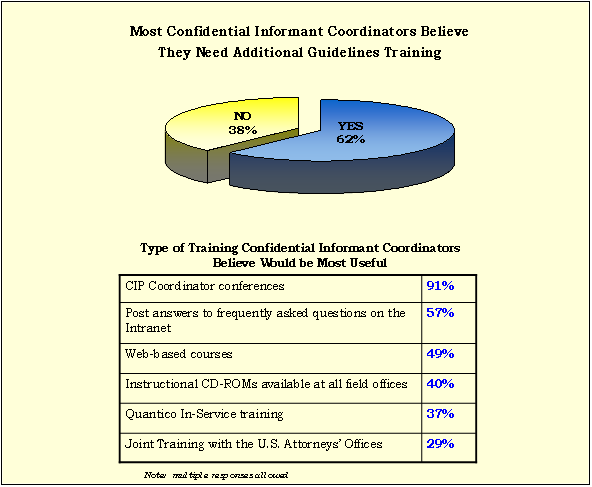
The reported effectiveness of the Investigative Guidelines training received by Informant Coordinators, Undercover Coordinators, and Division Counsel since the May 2002 revisions also is noteworthy. As the following diagrams reveal, a far greater percentage of Informant Coordinators than Undercover Coordinators reported receiving Guidelines training that they deemed "not effective."
DIAGRAM 8.4
Effectiveness of Training of Confidential Informant Coordinators
and Undercover Coordinators on the Investigative Guidelines
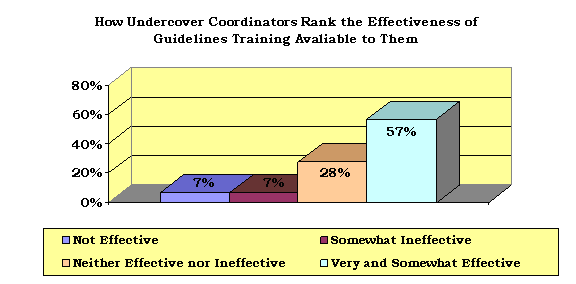
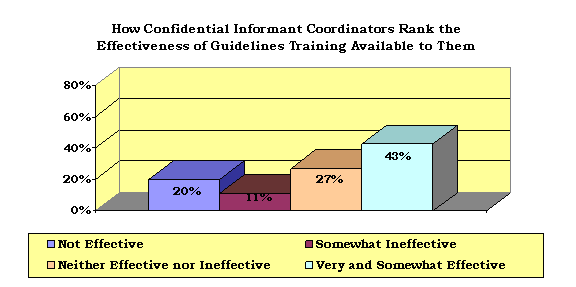
In addition, approximately 10 to 24 percent of surveyed Division Counsel reported receiving no training or ineffective training on each of the Guidelines in the first 21 months after the revised Guidelines were issued.
DIAGRAM 8.5
Division Counsel's Views on the Effectiveness of Their Training
on the Investigative Guidelines
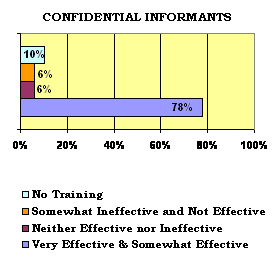
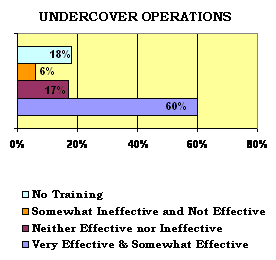
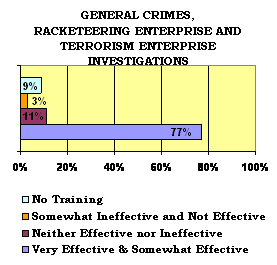
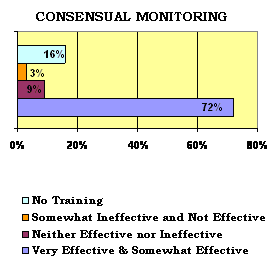
Compliance with regulations and policy requirements such as the Investigative Guidelines can be significantly enhanced through basic administrative measures, including use of accurate and up-to-date reference materials and standard forms, and adherence to procedures that ensure review by experienced personnel. As explained below, our review identified multiple deficiencies in the FBI's administrative support of the revised Guidelines. These included year-long delays in updating the MIOG and other administrative materials used to promote adherence to the Guidelines.
The MIOG is the FBI's official reference guide on operational procedures. It is compiled by the Manuals Desk of the FBI's Records Management Division (RMD), which maintains the document in electronic format on the FBI Intranet. The Manuals Desk revises the MIOG periodically at the request of FBI components. When the Manuals Desk receives such a request, it logs the revision into SOFTBOOK, the mainframe automated manuals application. After SOFTBOOK assigns a manual change number to the electronic communication requesting the revision, Manuals Desk personnel edit, type, proofread, and correct the amendments prior to uploading them into SOFTBOOK. SOFTBOOK tracks the upload date, manual change number, responsible division, and history associated with each manual citation. The date of the electronic communication requesting a manuals change is reflected as the "effective date" of the change in the text of the MIOG. However, this is not the date the change is uploaded to SOFTBOOK. Documentation provided to the OIG by RMD shows that many changes took as long as a year or more to appear in the "official" downloadable MIOG text available to agents on SOFTBOOK.
According to RMD, electronic communications amending the MIOG to conform to the revised Guidelines were submitted by OGC on July 23, 2002, September 23, 2002, and April 4, 2003; by the CTD on June 3, 2003; and by the CID on August 6, 2002.391 The FBI stated that SOFTBOOK uploads were completed for those five electronic communications on eight dates between April 2003 and July 2004.392 SOFTBOOK upload dates do not appear anywhere in the text of the MIOG. Thus, RMD did not receive all requests for MIOG revisions until more than one year after the Guidelines were modified and did not complete all the necessary changes until more than two years after the revised Guidelines were issued.
In contrast, USOU posted revisions to its operations manual on the FBI Intranet soon after revision of the Guidelines. For undercover operations, agents typically refer to the Field Guide which is available on the FBI's Intranet. To incorporate changes prompted by the revised Guidelines, USOU submitted a revised Field Guide to the Investigative Technology Operations Division within two weeks of the effective date of the new changes, which then uploaded it on the FBI Intranet.
In addition to examining the timing of the revisions to the MIOG and Field Guide, we also compared their text with the Guidelines, noting omissions and differences in language. We identified nine significant discrepancies between the Guidelines and their corresponding sections of the MIOG or field guides that were available to the field from May 2002 to May 2004. These differences range from omissions of Guidelines' requirements to contradictions in language.
Confidential Informants
Undercover Operations
General Crimes, Racketeering Enterprise and Terrorism Enterprise Investigations
Consensual Monitoring
In addition to delays in revising the MIOG and these discrepancies, we encountered numerous instances where the administrative support the FBI provided to implement the Guidelines was outdated or inadequate. For example, some standard forms in use in the field offices we visited were not current and contained requirements that had been superseded by the 2002 revisions.
Our review extended over a period of fundamental organizational change within the FBI in response to the terrorist attacks of September 11, 2001. Notwithstanding these significant challenges, we believe the May 2002 revisions to the Investigative Guidelines warranted more comprehensive implementation planning and training to ensure that they were effectively communicated to the field, understood, and followed.
Our review of the FBI's actions following the May 2002 revisions to the Guidelines showed that the FBI did not provide sufficient training, guidance, administrative support, and oversight to ensure adequate implementation of the revised Guidelines. Although we found that some FBI components took important actions to implement the Guidelines, such as the Undercover and Sensitive Operations Unit and the Office of the General Counsel, taken as a whole, the FBI's implementation process was insufficient.
In some respects, the FBI's efforts were destined to fall short because it failed to develop even a rudimentary plan for how it intended to disseminate and implement the revised Guidelines. This occurred despite the FBI's input on and prior knowledge of the impending Guidelines changes. We believe that someone at FBI Headquarters should have been assigned responsibility for overseeing implementation of the new Guidelines, in advance of their effective date.
Of all the implementation-related functions we examined, training on the revised Investigative Guidelines likely was hindered most significantly by the lack of inter-division coordination. For example, our interviews revealed that no entity in the FBI made decisions regarding the Guidelines training that should be provided throughout the FBI and the form it should take. As explained above, the Training Division does not have budgetary or operational authority over all training at the FBI, a fact which has been the topic of other reports critical of the FBI's training programs.396 In 2001, DOJ commissioned a study of FBI management, which concluded as follows: "The FBI's training and development function is fragmented across the organization, resulting in confusion among employees, duplication of efforts, gaps in training offerings and inefficient use of resources."397 Our review confirmed that training on the revised Investigative Guidelines suffered from similar deficiencies. Our surveys of FBI employees nearly two years after revision of the Guidelines showed that while 100 percent of agents in some offices had received training on individual Guidelines, agents in other offices had received no training, and most Informant Coordinators and Division Counsel believed that they, along with agents in their offices, still required additional training or guidance on the revised Guidelines.
We also found that certain of the FBI's administrative actions to support compliance with the Guidelines were outdated or otherwise deficient. For example, it took more than two years for the FBI to fully update the MIOG to account for the May 2002 Guidelines changes, even though the MIOG is the FBI's primary investigative resource manual. Moreover, during our field work in the summer 2004, we identified field-generated forms that field Divisions used to record information relevant to Guidelines compliance that were not current and that did not account for the May 2002 revisions.398 When preparing for future Guidelines changes, the FBI should ensure that its resource manuals and supporting materials are updated promptly.
Moreover, our comparison of the Investigative Guidelines and FBI policy manuals identified several discrepancies. These included omissions from the MIOG that addressed the contents of informant files, informant deactivation procedures, and the preparation of undercover employees. We also identified a conflict between the General Crimes Guidelines and the MIOG concerning authorizations for terrorism enterprise investigations.
We learned in the course of our review that OGC distributed copies of the revised Guidelines to all Chief Division Counsel the day after they became effective and announced their upcoming availability on the FBI Intranet. Thereafter, OGC and other FBI Headquarters divisions disseminated guidance to the field describing the modifications to the Guidelines in a reasonably prompt fashion. The Undercover and Sensitive Operation Unit did an especially good job in this regard, and distributed its guidance and announced a revised version of its field guide addressing key interpretive questions less than two weeks after the revised Guidelines became effective.
However, the guidance with regard to certain of the new counterterrorism authorities in the General Crimes Guidelines was not sufficient. As we explained in Chapter Five, our survey of Division Counsel in the FBI's field offices revealed that guidance relating to Part VI, which authorizes the FBI to visit public places without particularized predication, was not timely and comprehensive. We found, for example, that 86 percent of Division Counsel said they had been consulted about whether it was permissible to retain information derived from the surveillance of or attendance at public events, and that 63 percent of those Division Counsel believed there was inadequate guidance about these matters when the revised Investigative Guidelines were issued. When we surveyed them 21 months after the revised Guidelines were issued, their views on the clarity of guidance improved only slightly to 55 percent.399 Other communication gaps we identified appeared to have resulted from agents not knowing that guidance was issued or not consulting with others knowledgeable of the issues and current developments.
We recommend that the FBI take the following steps.
(44) Assign some person or unit at FBI Headquarters the responsibility to develop a plan to ensure proper and timely execution of future Attorney General Guidelines' revisions and to coordinate implementation of the revisions over time.
(45) Distribute revised Attorney General Guidelines to Chief Division Counsel, together with a concise summary or listing of the changes, sufficiently in advance of the new Guidelines' effective date to allow field personnel to familiarize themselves with the revisions and to allow those Headquarters and field personnel who provide training on the revisions to develop training materials and a schedule for providing training. In addition, near the effective date of the revision, the FBI should develop and distribute standardized forms and other administrative support tools, issue field guidance, and identify a Headquarters point of contact who can address questions concerning the revisions.
(46) Ensure that revisions to the MIOG accurately reflect any changes to the Attorney General Guidelines and are made on or about the effective date of such changes.
(47) Make appropriate changes to the MIOG to reconcile the discrepancies between the Attorney General Guidelines and the MIOG that are identified in this report.400
Footnotes
- The electronic communications for consensual monitoring, confidential informants, and undercover operations indicate that the following enclosures were provided: the consensual monitoring electronic communication included a copy of the revised Consensual Monitoring Guidelines; the confidential informant electronic communication included a revised MIOG Part 137; and the undercover operations electronic communication included a copy of the revised Field Guide, which contains a copy of the Undercover Guidelines.
- The comments of two Division Counsel are noteworthy. When asked what measures they believed should be taken to enhance compliance with the revised Investigative Guidelines, they responded:
- "[C]larity is needed from proposed/draft guidelines to the time they are enacted. This information seems to come in piecemeal."
- "Provide examples and clear answers. For example, the most recent CDC conference in November 2003, someone from OGC regurgitated the brand new AG Guidelines. But when asked a very specific, no-wiggle-room question about visiting a mosque, we got a non-answer as to what to do."
- For example, by invitation from various FBI Headquarters and field components, OGC conducted more than 20 training sessions addressing Guidelines issues from June 2002 to June 2003.
- According to the former Chief of the Criminal Intelligence Section (CIS), a project was initiated in November 2003 to provide FBI-wide "Back to Basics" training to all Special Agents, including managers, on the operation of human sources. All Informant Coordinators were provided a standard PowerPoint presentation to deliver to field agents. An instructional CD-ROM also was distributed that included a mandatory test. The former Section Chief explained that all FBI agents were trained the same way in approximately a 45-day period. He also stated that training is provided to the field through dissemination of Weekly Human Source Advisories, which discuss issues that come to the attention of the Informant Coordinators, such as the results of Inspection Division inspections. According to the former Section Chief, agents in the field find the MIOG to be a difficult source for answers and therefore very few agents consult the MIOG on informant issues. Instead, they consult with their Informant Coordinator, especially if they do not regularly operate informants.
- The FBI also provided documents which showed that OGC submitted a manuals change electronic communication concerning the revised Guidelines to RMD on September 30, 2002, and that the CID did the same on January 3, 2003.
- There were significant delays with the SOFTBOOK uploads. The dates of the uploads were April 8, 2003, November 4, 2003, November 12, 2003, March 2, 2004, March 3, 2004, March 4, 2004, March 10, 2004, and July 12, 2004.
- We construe the Undercover Guidelines' requirement that this letter "include a finding" that the benefits of the undercover operation outweigh its costs as adding something more to the letter than that the prosecutor "agrees with the proposal and its legality." As explained in Chapter Four, we found numerous instances when the authorization letter from the U.S. Attorney's Office did not meet the requirements of the Guidelines.
- In Chapter Five, we discuss the Attorney General's May 30, 2002, statements that the purpose of the Guidelines revisions delegating authority to field offices to approve TEIs was to eliminate "procedural red tape . . . [and to] free field agents to counter potential terrorist threats swiftly and vigorously without waiting for headquarters to act." Remarks of Attorney General John Ashcroft (May 30, 2002).
- A table listing these discrepancies is attached as Appendix F.
- See, e.g., Arthur Andersen, Management Study of the Federal Bureau of Investigation (December 14, 2001) at 159-160.
- Id. at 159.
- For example, as Table 3.7 in Chapter Three illustrates, 6 of the 12 field offices we visited during this review used one or more field-generated "ponies" or forms that failed to address important measures of the suitability of proposed confidential informants.
- As we also described in Chapter Five, a far greater percentage of surveyed Division Counsel were satisfied with the quality of the guidance generally on privacy and civil liberties issues: 37 percent found the guidance "fully satisfactory," 34 percent found it "somewhat satisfactory," and only 9 percent found it either "somewhat unsatisfactory" or "not satisfactory."
- We understand that the discrepancies we identify in this report concerning the Confidential Informant Guidelines may be overtaken by proposed changes to the FBI's internal rules for handling all human sources, including confidential informants. The FBI should decide whether it nonetheless should revise the MIOG in the interim period before the Guidelines revisions are made.


